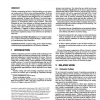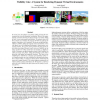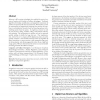20 search results - page 3 / 4 » OpenGL-assisted occlusion culling for large polygonal models |
IV
1999
IEEE
13 years 9 months ago
1999
IEEE
The aim of occlusion culling is to cull away a significant amount of invisible primitives at different viewpoints. We present two algorithms to improve occlusion culling for a hig...
SI3D
1999
ACM
13 years 9 months ago
1999
ACM
Visibility computation and level of detail modeling are two important components of efficient scenerendering algorithms. Both aim to lessen the graphics load by lowering polygon c...
ICVGIP
2008
13 years 6 months ago
2008
In recent years, the subject of occlusion culling of large 3D environments has received substantial contribution. However the major amount of research into the area has focussed o...
SIGGRAPH
2000
ACM
13 years 9 months ago
2000
ACM
Advances in 3D scanning technologies have enabled the practical creation of meshes with hundreds of millions of polygons. Traditional algorithms for display, simplification, and ...
VMV
2004
13 years 6 months ago
2004
In this paper, we present a novel, hardwareaccelerated approach to compute the visibility between surface points and directional light sources. Thus, our method provides a first-o...



